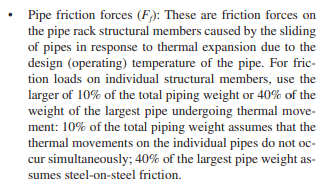I am working on a large industrial building where there are some significant piperack/trestle structures suspended from the underside of roof level,
The building will be fully clad, so these are internal structures,
They are large structures made out of light unistrut framing, they support mechanical and electrical services within the building,
For scale, some of these are 3.5m (11'5") tall (suspended down from the roof steelwork), 3.0m (9'10") wide and run throughout the length of the structure, circa 150m (490ft) long
My query is this;
I would like to hear your opinion on whether these piperacks should be designed for horizontal loading,
If so, have you experience with designing large internal structures/equipment for wind pressure due to internal wind loading (as you would apply to a partition wall say)or for a notional horizontal load ?
Have you any recommendations on horizontal loading to apply for the design?
There are no horizontal loads being applied from the pipework/electrical cabling that they are supporting, however, I believe it prudent to apply a notional horizontal load (be it from wind or other) to justify the stability of these large hanging structures, however some others I have spoken to believe otherwise,
Appreciate all thoughts on this,
Regards,
The building will be fully clad, so these are internal structures,
They are large structures made out of light unistrut framing, they support mechanical and electrical services within the building,
For scale, some of these are 3.5m (11'5") tall (suspended down from the roof steelwork), 3.0m (9'10") wide and run throughout the length of the structure, circa 150m (490ft) long
My query is this;
I would like to hear your opinion on whether these piperacks should be designed for horizontal loading,
If so, have you experience with designing large internal structures/equipment for wind pressure due to internal wind loading (as you would apply to a partition wall say)or for a notional horizontal load ?
Have you any recommendations on horizontal loading to apply for the design?
There are no horizontal loads being applied from the pipework/electrical cabling that they are supporting, however, I believe it prudent to apply a notional horizontal load (be it from wind or other) to justify the stability of these large hanging structures, however some others I have spoken to believe otherwise,
Appreciate all thoughts on this,
Regards,

![[bigears] [bigears] [bigears]](/data/assets/smilies/bigears.gif)
